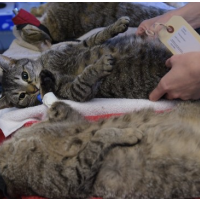St. Louis Medical School Ends Controversial Use of Sedated Cats in Neonatal Training
 Cats being prepped for procedure (photo: Mandel Ngan, AFP/Getty Images)
Cats being prepped for procedure (photo: Mandel Ngan, AFP/Getty Images)
By Jim Salter, Associated Press
ST. LOUIS (AP) — Washington University in St. Louis said Monday that it has stopped using sedated cats to train medical students how to insert breathing tubes down babies' throats, effectively ending the practice in the U.S., according to a medical ethics group.
The university's School of Medicine said in a statement that after a "significant investment" in its simulation center, it will now provide neonatal intubation training using only mannequins and advanced simulators, effective immediately.
The school said improvements in simulators made the change possible. Cats currently at the university are being adopted by employees of the medical center.
"In the 25-plus years the university has relied on cats in teaching this procedure, none was harmed during training," the statement read.
The Physicians Committee for Responsible Medicine, a medical ethics nonprofit, applauded the decision, saying the practice was cruel to animals and unnecessary for students. The group said it was the last of the 198 U.S. pediatrics programs still using cats.
"The best way to teach emergency airway intervention is on human-relevant training methods. I commend Washington University for switching to modern methods," said Dr. John Pippin, director of academic affairs for the Physicians Committee.
Washington University's use of cats has drawn criticism in recent years, with critics contending that the animals suffer pain and injuries ranging from cracked teeth to punctured lungs. Protests broke out in 2013 after an undercover video of the university's training in pediatric advanced life support was released by People for the Ethical Treatment of Animals. The video shows a trainee putting tubes down the throat of a sedated cat, sometimes struggling to get it right. However, the medical school continued using sedated cats in other training programs prior to Monday' announcement.
But university officials have said the lab consistently met federal Animal Welfare Act standards, including passing an inspection by the U.S. Department of Agriculture soon after the PETA video.
Other teaching labs have used simulators for years, but Washington University previously cited research indicating that pediatric doctors in training only succeed in 20 percent to 35 percent of their initial attempts to intubate infants, justifying the need for animals in training.
The program previously used ferrets, too, but university spokeswoman Judy Martin said ferrets have not been used for many years.
- Top Stories
- Unusual News
- Where is the Money Going?
- Controversies
- U.S. and the World
- Appointments and Resignations
- Latest News
- Trump to Stop Deportations If…
- Trump Denounces World Series
- What If China Invaded the United States?
- Donald Trump Has a Mental Health Problem and It Has a Name
- Trump Goes on Renaming Frenzy






Comments